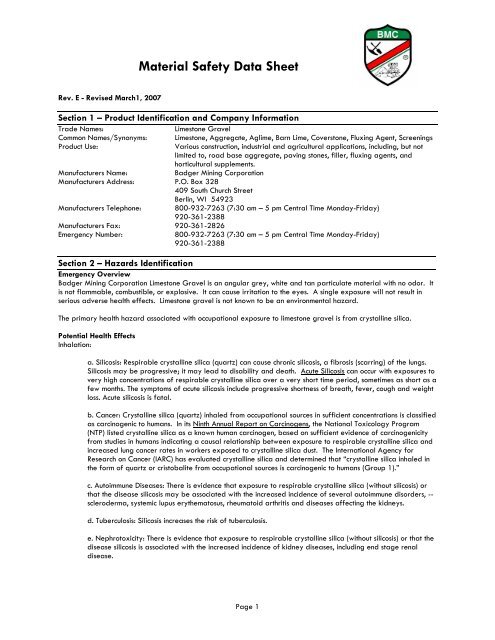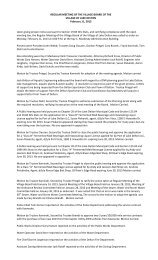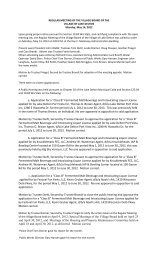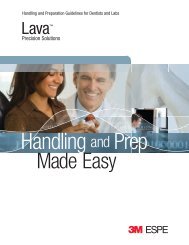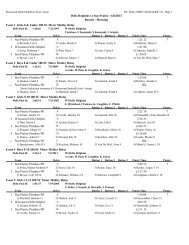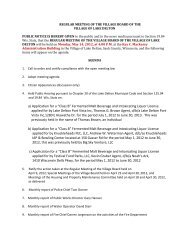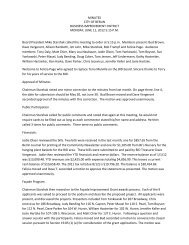Material Safety Data Sheet
Material Safety Data Sheet
Material Safety Data Sheet
You also want an ePaper? Increase the reach of your titles
YUMPU automatically turns print PDFs into web optimized ePapers that Google loves.
<strong>Material</strong> <strong>Safety</strong> <strong>Data</strong> <strong>Sheet</strong><br />
Rev. E - Revised March1, 2007<br />
Section 1 – Product Identification and Company Information<br />
Trade Names:<br />
Limestone Gravel<br />
Common Names/Synonyms: Limestone, Aggregate, Aglime, Barn Lime, Coverstone, Fluxing Agent, Screenings<br />
Product Use:<br />
Various construction, industrial and agricultural applications, including, but not<br />
limited to, road base aggregate, paving stones, filler, fluxing agents, and<br />
horticultural supplements.<br />
Manufacturers Name:<br />
Badger Mining Corporation<br />
Manufacturers Address: P.O. Box 328<br />
409 South Church Street<br />
Berlin, WI 54923<br />
Manufacturers Telephone: 800-932-7263 (7:30 am – 5 pm Central Time Monday-Friday)<br />
920-361-2388<br />
Manufacturers Fax: 920-361-2826<br />
Emergency Number:<br />
800-932-7263 (7:30 am – 5 pm Central Time Monday-Friday)<br />
920-361-2388<br />
Section 2 – Hazards Identification<br />
Emergency Overview<br />
Badger Mining Corporation Limestone Gravel is an angular grey, white and tan particulate material with no odor. It<br />
is not flammable, combustible, or explosive. It can cause irritation to the eyes. A single exposure will not result in<br />
serious adverse health effects. Limestone gravel is not known to be an environmental hazard.<br />
The primary health hazard associated with occupational exposure to limestone gravel is from crystalline silica.<br />
Potential Health Effects<br />
Inhalation:<br />
a. Silicosis: Respirable crystalline silica (quartz) can cause chronic silicosis, a fibrosis (scarring) of the lungs.<br />
Silicosis may be progressive; it may lead to disability and death. Acute Silicosis can occur with exposures to<br />
very high concentrations of respirable crystalline silica over a very short time period, sometimes as short as a<br />
few months. The symptoms of acute silicosis include progressive shortness of breath, fever, cough and weight<br />
loss. Acute silicosis is fatal.<br />
b. Cancer: Crystalline silica (quartz) inhaled from occupational sources in sufficient concentrations is classified<br />
as carcinogenic to humans. In its Ninth Annual Report on Carcinogens, the National Toxicology Program<br />
(NTP) listed crystalline silica as a known human carcinogen, based on sufficient evidence of carcinogenicity<br />
from studies in humans indicating a causal relationship between exposure to respirable crystalline silica and<br />
increased lung cancer rates in workers exposed to crystalline silica dust. The International Agency for<br />
Research on Cancer (IARC) has evaluated crystalline silica and determined that “crystalline silica inhaled in<br />
the form of quartz or cristobalite from occupational sources is carcinogenic to humans (Group 1).”<br />
c. Autoimmune Diseases: There is evidence that exposure to respirable crystalline silica (without silicosis) or<br />
that the disease silicosis may be associated with the increased incidence of several autoimmune disorders, --<br />
scleroderma, systemic lupus erythematosus, rheumatoid arthritis and diseases affecting the kidneys.<br />
d. Tuberculosis: Silicosis increases the risk of tuberculosis.<br />
e. Nephrotoxicity: There is evidence that exposure to respirable crystalline silica (without silicosis) or that the<br />
disease silicosis is associated with the increased incidence of kidney diseases, including end stage renal<br />
disease.<br />
Page 1
Badger Mining Corporation Last Revised: March 2007<br />
MSDS for Limestone Gravel<br />
Eye Contact: Crystalline silica (quartz) may cause abrasion of the cornea.<br />
Skin Contact: May cause abrasion to skin.<br />
Ingestion: No known health effect.<br />
Acute Effects: One form of silicosis, Acute Silicosis, can occur with exposures to very high concentrations of respirable<br />
crystalline silica over a very short time period, sometimes as short as a few months. The symptoms of acute silicosis<br />
include progressive shortness of breath, fever, cough and weight loss. Acute silicosis is fatal.<br />
Chronic Effects: The adverse health effects -– lung disease, silicosis, cancer, autoimmune disease, tuberculosis, and<br />
nephrotoxicity -- are chronic effects.<br />
Signs and Symptoms of Exposure: There are generally no signs or symptoms of exposure to crystalline silica (quartz).<br />
Often, chronic silicosis has no symptoms. The symptoms of chronic silicosis, if present, are shortness of breath,<br />
wheezing, cough and sputum production. The symptoms of acute silicosis are the same as those associated with chronic<br />
silicosis; additionally, weight loss and fever may also occur. The symptoms of scleroderma include thickening and<br />
stiffness of the skin, particularly in the fingers, shortness of breath, difficulty swallowing and joint problems.<br />
Medical Conditions Generally Aggravated by Exposure: The condition of individuals with lung disease (e.g.,<br />
bronchitis, emphysema, chronic obstructive pulmonary disease) can be aggravated by exposure.<br />
See Section 11, Toxicological Information, for additional detail on potential adverse health effects.<br />
Section 3 – Composition and Information on Ingredients<br />
Chemical Name:<br />
Limestone<br />
Specific Chemical Identity: Calcium Carbonate<br />
CAS Number: 1317-65-3<br />
Concentration (%): >99<br />
Hazardous Ingredient<br />
Name:<br />
Silica, Quartz, SiO2<br />
CAS Number: 14808-60-7<br />
Concentration (%): Composition varies naturally; typically contains
Badger Mining Corporation Last Revised: March 2007<br />
MSDS for Limestone Gravel<br />
Section 6 – Accidental Release Measures<br />
Wear appropriate personal protective equipment as described in Section 8 of this document. Collect the material<br />
using a method that does not produce dust, e.g., wet methods or a High-Efficiency Particulate Air (HEPA) vacuum.<br />
Place the limestone in a covered container appropriate for disposal. Dispose of the limestone according to federal,<br />
state, and local regulations.<br />
Section 7 – Handling and Storage<br />
Do not breathe dust that may be created during the handling of this product. Do not rely on vision to determine<br />
whether respirable silica is present in the air, as it may be present without a visible cloud. Use good housekeeping<br />
procedures to prevent the accumulation of limestone and silica dust in the workplace. Avoid the creation of<br />
respirable dust.<br />
Use adequate ventilation and dust collection equipment. Ensure that the dust collection system is adequate to reduce<br />
airborne dust levels to below the appropriate occupational exposure limits. Use respiratory protection during the<br />
establishment of engineering controls. Refer to Section 8 - Exposure Controls/Personal Protection for further<br />
information.<br />
In accordance with the U.S. Occupational <strong>Safety</strong> and Health Administration’s (OSHA) Hazard Communication<br />
Standard (29 CFR 1910.1200, 1915.99, 1917.28, 1918.90, 1926.59, 1928.21), state, and/or local right-to-know<br />
laws and regulations, familiarize your employees with this MSDS and the information contained herein. Warn your<br />
employees (and your customers in case of resale) of the potential health risks associated with the use of this product<br />
and train them in the appropriate use of personal protective equipment and engineering controls, which will reduce<br />
their risks of exposure.<br />
See also ASTM International standard practice E 1132-06, "Standard Practice for Health Requirements Relating to<br />
Occupational Exposure to Respirable Crystalline Silica."<br />
Crystalline silica is listed by the Governor of the State of California, under Proposition 65, as requiring the following<br />
warning: “Detectable amounts of chemicals known to the State of California to cause cancer, birth defects, or other<br />
reproductive harm may be found in this product.”<br />
Section 8 – Exposure Controls/Personal Protection<br />
Exposure Limits in Air (crystalline silica as quartz):<br />
OSHA - PEL 10 mg/m 3<br />
% SiO2+2 (8-Hr. Time Weighted Average)<br />
ACGIH – TLV 0.025 mg/m 3 (8-Hr. Time Weighted Average)<br />
NIOSH - REL 0.05 mg/m 3 (10-Hr. Time Weighted Avg., 40-hr. work week)<br />
Exposure Limits refer to the respirable fraction<br />
Silica is classified as hazardous under Occupational <strong>Safety</strong> and Health Administration (OSHA) regulations (29 CFR<br />
1910.1200).<br />
CAUTION:<br />
Crystalline silica exists in several forms, the most common of which is quartz. If crystalline silica (quartz) is heated to<br />
more than 870°C (1598°F) it can change to a form of crystalline silica known as trydimite, and if crystalline silica<br />
(quartz) is heated to more than 1470°C (2678°F), it can change to a form of crystalline silica known as cristobalite.<br />
Crystalline silica as trydimite and cristobalite are more fibrogenic than crystalline silica as quartz. The OSHA PEL for<br />
crystalline silica as trydimite and cristobalite is one-half the PEL for crystalline silica (quartz); the ACGIH TLV for<br />
crystalline silica as cristobalite is equal to the TLV for crystalline silica as quartz. The ACGIH, in 2005, has withdrawn<br />
the TLV for crystalline silica as trydimite.<br />
Ventilation:<br />
Use local exhaust as required to maintain exposures below the appropriate<br />
occupational exposure limits; see also ACGIH, Industrial Ventilation –<br />
Recommended Practice (latest edition).<br />
Page 3
Badger Mining Corporation Last Revised: March 2007<br />
MSDS for Limestone Gravel<br />
Respiratory Protection:<br />
Gloves:<br />
Eye:<br />
Other:<br />
Consult with OSHA regulations and NIOSH recommendations to determine the<br />
appropriate respiratory protection during use of this product. Use only NIOSHapproved<br />
respiratory protection equipment. Avoid breathing dust produced<br />
during the use and handling of this product. If the workplace airborne crystalline<br />
silica concentration is unknown for a given task, conduct air monitoring to<br />
determine the appropriate level of respiratory protection. Consult with a<br />
certified industrial hygienist, your insurance risk manager, or the OSHA<br />
Consultative Services group for detailed information. Ensure appropriate<br />
respirators are worn during and following the task, including clean up or<br />
whenever airborne dust is present, to ensure worker exposures remain below<br />
occupational exposure limits. Provisions should be made for a respiratory<br />
protection training program (see 29 CFR 1910.134 – Respiratory Protection for<br />
minimum program requirements). See also ANSI standard Z88.2 (latest revision)<br />
"American National Standard for Respiratory Protection," 29 CFR 1910.134 and<br />
1926.103, and 42 CFR 84.<br />
Recommended in situations where abrasion may occur.<br />
Use protection as appropriate for the task at hand.<br />
Use protective clothing as appropriate for the work environment.<br />
Section 9 – Physical and Chemical Properties<br />
Appearance:<br />
Angular grey, white, tan particles, varied sizes<br />
Odor:<br />
None<br />
Physical State:<br />
Solid<br />
pH:<br />
Not Applicable<br />
Vapor Pressure<br />
Not Applicable<br />
Vapor Density:<br />
Not Applicable<br />
Boiling Point or Range, °F: none (calcium carbonate)<br />
Melting Point or Range, °F: 1,517 (decomposes) (calcium carbonate)<br />
Solubility In Water:<br />
Insoluble<br />
Specific Gravity:<br />
2.7-2.95 (calcium carbonate)<br />
Section 10 – Stability and Reactivity<br />
Stability:<br />
<strong>Material</strong>s to Avoid:<br />
Hazardous Decomposition Products:<br />
Hazardous Polymerization:<br />
Stable<br />
Strong Oxidizing Agents, such as fluorine, chlorine trifluoride,<br />
hydrogen fluoride, and oxygen difluoride.<br />
Limestone will dissolve in hydrofluoric acid and produce a corrosive<br />
gas – silicon tetrafluoride.<br />
Will not occur<br />
Section 11 – Toxicological Information<br />
A. SILICOSIS<br />
The major concern is silicosis (lung disease), caused by the inhalation and retention of respirable crystalline silica dust.<br />
Silicosis can exist in several forms, chronic (or ordinary), accelerated, or acute.<br />
Chronic or Ordinary Silicosis is the most common form of silicosis, and can occur after many years of exposure to<br />
levels above the occupational exposure limits for airborne respirable crystalline silica dust. It is further defined as<br />
either simple or complicated silicosis.<br />
Simple silicosis is characterized by lung lesions (shown as radiographic opacities) less than 1 centimeter in diameter,<br />
primarily in the upper lung zones. Often, simple silicosis is not associated with symptoms, detectable changes in lung<br />
function or disability. Simple silicosis may be progressive and may develop into complicated silicosis or progressive<br />
massive fibrosis (PMF).<br />
Page 4
Badger Mining Corporation Last Revised: March 2007<br />
MSDS for Limestone Gravel<br />
Complicated silicosis or PMF is characterized by lung lesions (shown as radiographic opacities) greater than 1<br />
centimeter in diameter. Although there may be no symptoms associated with complicated silicosis or PMF, the<br />
symptoms, if present, are shortness of breath, wheezing, cough and sputum production. Complicated silicosis or PMF<br />
may be associated with decreased lung function and may be disabling. Advanced complicated silicosis or PMF may<br />
lead to death. Advanced complicated silicosis or PMF can result in heart disease (cor pumonale) secondary to the lung<br />
disease.<br />
Accelerated Silicosis can occur with exposure to high concentrations of respirable crystalline silica over a relatively<br />
short period; the lung lesions can appear within five (5) years of the initial exposure. The progression can be rapid.<br />
Accelerated silicosis is similar to chronic or ordinary silicosis, except that the lung lesions appear earlier and the<br />
progression is more rapid.<br />
Acute Silicosis can occur with exposures to very high concentrations of respirable crystalline silica over a very short<br />
time period, sometimes as short as a few months. The symptoms of acute silicosis include progressive shortness of<br />
breath, fever, cough and weight loss. Acute silicosis is fatal.<br />
B. CANCER<br />
IARC - The International Agency for Research on Cancer ("IARC") concluded that there was "sufficient evidence in<br />
humans for the carcinogenicity of crystalline silica in the forms of quartz or cristobalite from occupational sources",<br />
and that there is "sufficient evidence in experimental animals for the carcinogenicity of quartz and cristobalite." The<br />
overall IARC evaluation was that "crystalline silica inhaled in the form of quartz or cristobalite from occupational<br />
sources is carcinogenic to humans (Group 1)." The IARC evaluation noted that not all industrial circumstances studied<br />
evidenced carcinogenicity. The monograph also stated that “[C]arcinogenicity may be dependent on inherent<br />
characteristics of the crystalline silica or on external factors affecting its biological activity or distribution of its<br />
polymorphs." For further information on the IARC evaluation, see IARC Monographs on the Evaluation of Carcinogenic<br />
Risks to Humans, Volume 68, "Silica, Some Silicates..." (1997).<br />
NTP - The National Toxicology Program, in its Ninth Annual Report on Carcinogens, concluded that respirable<br />
crystalline silica is known to be a human carcinogen, based on sufficient evidence of carcinogenicity from studies in<br />
humans indicating a causal relationship between exposure to respirable crystalline silica and increased lung cancer<br />
rates in workers exposed to crystalline silica dust.<br />
OSHA – Not regulated as a carcinogen.<br />
There have been many articles published on the carcinogenicity of crystalline silica, which the reader should consult<br />
for additional information; the following are examples of recently published articles: (1) “Lung cancer among<br />
industrial sand workers exposed to crystalline silica”, Am J Epidemiol, (153) 695-703 (2001); (2) "Crystalline Silica<br />
and the risk of lung cancer in the potteries", Occup Environ Med, (55) 779-785 (1998); (3) "Is Silicosis Required for<br />
Silica-Associated Lung Cancer", American Journal of Industrial Medicine, (37) 252- 259 (2000); (4) " Silica, Silicosis,<br />
and Lung Cancer: A Risk Assessment", American Journal of Industrial Medicine, (38) 8-18 (2000); (5) "Silica, Silicosis,<br />
and Lung Cancer: A Response to a Recent Working Group Report", Journal of Occupational and Environmental<br />
Medicine, (42) 704-720 (2000).<br />
C. AUTOIMMUNE DISEASES<br />
There is evidence that exposure to respirable crystalline silica (without silicosis) or that the disease silicosis may be<br />
associated with the increased incidence of several autoimmune disorders, -- scleroderma, systemic lupus<br />
erythematosus, rheumatoid arthritis and diseases affecting the kidneys. For a review of the subject, the following may<br />
be consulted: "Occupational Exposure to Crystalline Silica and Autoimmune Disease", Environmental Health<br />
Perspectives, (107) Supplement 5, 793-802 (1999); "Occupational Scleroderma", Current Opinion in Rheumatology,<br />
(11) 490-494 (1999); “Connective tissue disease and silicosis”, Am J Ind Med, (35), 375-381 (1999).<br />
D. TUBERCULOSIS<br />
Individuals with silicosis are at increased risk to develop pulmonary tuberculosis, if exposed to persons with<br />
tuberculosis. The following may be consulted for further information: Occupational Lung Disorders, Third Edition,<br />
Chapter 12, entitled "Silicosis and Related Diseases", Parkes, W. Raymond (1994); "Risk of pulmonary tuberculosis<br />
relative to silicosis and exposure to silica dust in South African gold miners," Occup Environ Med, (55) 496-502<br />
(1998); “Occupational risk factors for developing tuberculosis”, Am J Ind Med, (30) 148-154 (1996).<br />
Page 5
Badger Mining Corporation Last Revised: March 2007<br />
MSDS for Limestone Gravel<br />
E. KIDNEY DISEASE<br />
There is evidence that exposure to respirable crystalline silica (without silicosis) or that the disease silicosis is<br />
associated with the increased incidence of kidney diseases, including end stage renal disease. For additional<br />
information on the subject, the following may be consulted: "Kidney Disease and Silicosis", Nephron, (85) 14-19<br />
(2000); “End stage renal disease among ceramic workers exposed to silica”, Occup Environ Med, (56) 559-561<br />
(1999); “Kidney disease and arthritis in a cohort study of workers exposed to silica”, Epidemiology, (12) 405-412<br />
(2001).<br />
F. NON-MALIGNANT RESPIRATORY DISEASES<br />
NIOSH has cited the results of studies that report an association between dusts found in various mining operations and<br />
non-malignant respiratory disease, particularly among smokers, including bronchitis, emphysema, and small airways<br />
disease. The results were not conclusive regarding an association among those with silicosis, only smokers, or the<br />
result of general mineral dust that does not contain silica. See NIOSH Hazard Review – Health Effects of Occupational<br />
Exposure to Respirable Crystalline Silica, published in April 2002, available from NIOSH, 4676 Columbia Parkway,<br />
Cincinnati, OH 45226, or at http://www.cdc.gov/niosh/02-129A.html.<br />
Section 12 – Ecological Information<br />
Limestone is not known to be ecotoxic.<br />
Section 13 – Disposal Considerations<br />
General: Limestone may be landfilled. <strong>Material</strong> should be placed in covered containers to minimize<br />
generation of airborne dust.<br />
RCRA:<br />
Limestone is not classified as a hazardous waste under the Resource Conservation and Recovery<br />
Act, or its regulations, 40 CFR §261 et seq.<br />
The above information applies to Badger Mining Corporation Limestone only as sold. The product may be<br />
contaminated during use, and it is the responsibility of the user to assess the appropriate disposal method in this<br />
situation.<br />
Section 14 – Transport Information<br />
Limestone is not a hazardous material for purposes of transportation under the U. S. Department of Transportation<br />
Table of Hazardous <strong>Material</strong>s, 49 CFR §172.101.<br />
Section 15 – Regulatory Information<br />
UNITED STATES (FEDERAL AND STATE)<br />
TSCA No.: Crystalline silica (quartz) appears on the EPA TSCA inventory under the CAS No. 14808-60-7.<br />
RCRA: Limestone is not classified as a hazardous waste under the Resource Conservation and Recovery Act,<br />
or its regulations, 40 CFR §261 et seq.<br />
CERCLA: Limestone is not classified as a hazardous substance under regulations of the Comprehensive<br />
Environmental Response Compensation and Liability Act (CERCLA), 40 CFR §302.<br />
Emergency Planning and Community Right to Know Act: Limestone is not an extremely hazardous substance<br />
under Section 302 and is not a toxic chemical subject to the requirements of Section 313.<br />
Clean Air Act: Limestone mined and processed by Badger Mining Corporation was not processed with or<br />
does not contain any Class I or Class II ozone depleting substances.<br />
NTP: Limestone is not classified as a carcinogen. Its naturally occurring component, crystalline silica (quartz),<br />
is classified as a known human carcinogen.<br />
OSHA Carcinogen: Limestone is not listed.<br />
California Proposition 65:Limestone is not classified by the State of California. Crystalline silica (quartz) is<br />
classified as a substance known to the state of California to be a carcinogen.<br />
California Inhalation Reference Exposure Limit (REL): The California chronic REL for respirable crystalline<br />
silica is 3 ug/m 3 . A chronic REL is an airborne level of a substance at or below which no adverse health<br />
effects are anticipated in individuals indefinitely exposed to the substance at that level.<br />
Massachusetts Toxic Use Reduction Act: Respirable crystalline silica is considered toxic per the Massachusetts<br />
Toxic Use Reduction Act.<br />
Pennsylvania Worker and Community Right to Know Act: Quartz is considered hazardous for purposes of the<br />
Act, but it is not a special hazardous substance or an environmental hazardous substance.<br />
Page 6
Badger Mining Corporation Last Revised: March 2007<br />
MSDS for Limestone Gravel<br />
CANADA<br />
Domestic Substances List: Badger Mining Corporation products, as naturally occurring substances, are on the<br />
Canadian DSL.<br />
WHMIS Classification: D-2A (for crystalline silica).<br />
OTHER<br />
EINECS No.: 231-545-4 (for crystalline silica).<br />
EEC Label (Risk/<strong>Safety</strong> Phrases): R 48/20, R 40/20, S22, S38 (for crystalline silica).<br />
IARC: Limestone is not classified by IARC. Crystalline silica (quartz) is classified in IARC Group 1.<br />
National, state, provincial or local emergency planning, community right to know or other laws, regulations<br />
or ordinances may be applicable--consult applicable national, state, provincial or local laws.<br />
Section 16 – Other Information<br />
An electronic version of this MSDS is available at www.badgerminingcorp.com . More information on the effects of<br />
crystalline silica exposure may be obtained from the Occupational <strong>Safety</strong> and Health Administration (OSHA) (phone<br />
number: 1-800-321-OSHA; website: http://www.osha.gov) or from the National Institute for Occupational <strong>Safety</strong><br />
and Health (NIOSH) (phone number: 1-800-35-NIOSH; website: http://www.cdc.gov/niosh).<br />
HMIS:<br />
Health:<br />
See Section 2 and Section 11 of this MSDS.<br />
Flammability: 0<br />
Reactivity: 0<br />
Protective Equipment:<br />
E<br />
NFPA<br />
Health: 0<br />
Flammability: 0<br />
Reactivity: 0<br />
Page 7


